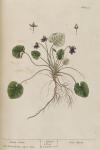053-056 Male Satyrion, Hollyhocks, March Violet, White Saxifrage.


 53. Male Satyrion, or Male Fools-Stones. Satyrium mas.
53. Male Satyrion, or Male Fools-Stones. Satyrium mas.
1. This Orchis, which is the common Satyrion of the Shops, grows to be a Foot high; the Leaves are a bright Green spotted with Black, and the Flowers, which grow on a brownish Stalk, are a Red Purple.
2. It grows in moist Meadows, and flowers in April and May.
3. The Roots are accounted a Stimulus to Venery, strengthening the Genital Parts, and helping Conception; and for these Purposes are a chief Ingredient in the Electuarium Diasatyrum.
Outwardly they are applied in form of a Cataplasm, and are esteemed good to dissolve hard Tumours and Swellings.
The Officinal Preparation is the Electuarium Diasatyrium.
Dioscorides says, that the Roots of this Plant boiled and eat by Men, makes them beget Boys; and the Roots of the Female Satyrion eat by Women, makes them Conceive Girls.
4. Greek, Όρχις Theophrastus. Σατύριον τριφυλλον Dioscorid's. Latin, Satyrium mas, or Testiullus mononis (?). Spanish, Coyon de perro. Italian, Testicolo di Cane. French, Coullon de Prestres. German, Schmal Knabencraut meunle. Dutch, Kulletjeskruyd.

 54. Hollyhocks. Malva hortensis.
54. Hollyhocks. Malva hortensis.
Also see #022, Common Mallow.
1. This Plant grows six or seven Foot high; the Leaves are a light green, and the Flowers a pale Red.
2. It grows in Gardens, and flowers in July and August.
3. Hollyhocks are much of the Nature of the common Mallows, vid. Plate 22. but less mollifying; they are mostly used in Gargles for the Swelling of the Tonsils, and Relaxation of the Uvula.
4. Greek, δενδρομαλάχη Camerarius. Latin, Malva hortensis. Spanish, Malvas. Italian, Malva maggiore. French, Malves de Jardin. German, Ernrosen. Dutch, Stockrosen.

 55. March Violet. Viola martia.
55. March Violet. Viola martia.
Also see #044, Pansies or Hearts-Ease.
1. The Stalks of this Violet creep on the Ground; the Leaves are a dark Green, and the Flowers a blue Purple.
2. It grows wild in Hedges, and is cultivated likewise in Gardens; and flowers in March.
3. The Flowers are on of the four Cordial Flowers; & esteemed cooling, moistning, and laxative, good in Affections of the Breast and Lungs, helping Coughs and pleuritic Pains.
The Syrup is given to Children to open and cool their bodies.
The Leaves are cooling and opening, and frequently put into Glisters, and Ointments against Inflammations.
The Seed is reckon'd good for the Stone and Gravel.
The Officinal Preparation is the Syrupus Violarum.
4. Greek, Υιολαξον, Dioscorides. Latin, Viola martia. Spanish, Violetta. Italian, Viola. French, Violette. German, MerkenBiolen. Dutch, Diole.

 56. White Saxifrage. Saxifraga alba.
56. White Saxifrage. Saxifraga alba.
Also see #056. White Saxifrage - #212. Rue-leaved Whitlow Grass
1. White Saxifrage grows to be a foot high; the Leaves are a light Green and the Flowers White, with Yellow Apices.
2. It grows in Meadows and flowers in April and May.
3. This Plant takes its Name from its supposed Virtues being diuretic, and lithontriptic, good for the Stone and Gravel, and Stoppage of Vrine.
The Officinal Preparation is Simple Water.
4. Greek, -. Latin, Saxifraga alba. Spanish, -. Italian, -. French, -. German, -. Dutch, Steenbreuk.

